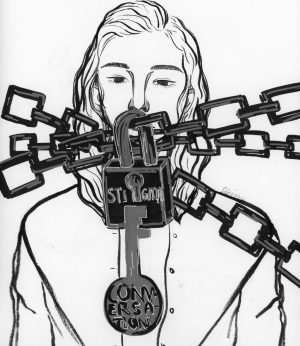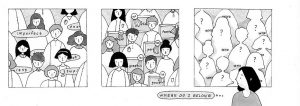Saying “hypermasculinity” reinforces gender roles
April 3, 2019
The term “hypermasculinity” is unprogressive. We say it before really analyzing its implications.
When I discuss hypermasculinity, the terms I hear most often are “aggressive,” “dominant” and “privileged.” However, it is not these traits, nor any traits, that make someone hypermasculine. For example, some may say that aggression, dominance and privilege are characteristically “masculine.” Yet, categorizing someone as masculine due to aggression only serves to further the stereotype that only men can be aggressive. Both males and females can possess these traits, both males and females are capabale of exaggerating these traits to the point at which it becomes toxic for the audience of this behavior. (It should be noted that audience isn’t a specific gender.)
None of the traits associated with hypermasculinity are inherently bad, but our response to these traits can become destructive rather quickly. For example, is it someone’s privilege that makes them condescending and prejudiced, or is it their reaction to having that privilege? No; there is a big difference between having the ability to take advantage of your privilege, and actually doing so. However, when a person does use their privilege as an advantage against individuals who don’t have the same privilege, it emphasizes their superiority over the individual. It is the purposeful exaggeration of these stereotypes upon an audience that is toxic.
Thus, “hypermasculinity” is a reaction to the stereotypes placed on men — a reaction that exaggerates those stereotypes, ultimately limiting both men and women alike.
If both genders can possess the same supposedly “masculine” traits, what does it mean to be “hypermasculine?”
The term “hypermasculinity” shouldn’t exist. Hyperaggression exists, but “hypermasculinity” is a facade created by gender norms that society has placed on itself. Think about it; we coined the term to criticize gender roles, but in doing so, we reinforce the stereotype that only men can demonstrate aggressive behavior. Changing our verbage to address “hypermasculinity” as hyperaggression accounts for this spectrum of abuses.
This comes from the evolution of stereotypes. According to Samuel Veissière, an Assistant Professor of Psychiatry at McGill University, “Stereotypes exist for the purpose of informational efficiency. They describe, however crudely, patterns of behaviors and statistical regularities in the world that can be figured out with no explicit instruction. Babies recognize patterns in the world and form mental templates to organize this information into stereotypes … we know that human behavior and the cultural patterning of behavior are rooted in our evolved biology.”
Aggression in females is thus seen as an inconsistency that sparks a negative reaction in which the responder attempts to “fix” the mistake by punishing girls for breaking gender boundaries or is largely ignored because it doesn’t make sense to the brain.
Debate is the perfect example of this. While I don’t consider myself an extremely aggressive debater, I do hold my ground and prevent my opponents from dominating me. However, my judges do not always view my debating style that way. I distinctly remember facing male opponents with a male partner, and the first judge’s comment was that I was “unnecessarily rude,” even though both my opponent and I maintained the same level of aggression. This is where the consequences of hyperaggression become drastically clear: I am disadvantaged because I don’t have access to certain traits that my male opponent possesses. And when opponents know that judges will not perceive those traits equally, they capitalize on it and use it to win rounds. And this isn’t just limited to debate. The workplace, for example, undermines womxn and forces them to meet the dual standard of both asserting themselves and not getting antagonized. Women who assert themselves are “b–ches.” Womxn who are amiable are “cute.”
And this “cuteness” undermines her authority, bagging down the go-getter of a womxn into her traditional role of being submissive and weak.
While rejecting the double standard seems like the “feminist” approach, womxn constantly have to weigh the benefits of doing so, because they are simply unlikely to be successful if they stay true to their values.
This applies to men as well, but the outcome is different. According to Evan Liddle, a World Geography, AP World History and Mock Trial teacher at Dougherty Valley, “It [hypermasculinity] locks you into a mindset of ‘Don’t try something new. There’s a set way to do it. If you don’t do those things you’re not a real man.’”
Men are pressured into conforming to the ‘norm’ or risking rejection of that identity.
But this is incorrectly overgeneralized as hypermasculinity; there are infinite scenarios in which an individual manipulates and uses a trait against one who cannot. It is a form of hyperaggression that we have deemed “hypermasculine.” In reality, there is a wide scope of similar scenarios. Going back to the debate example, if a more experienced womxn debater were to purposefully use excessive aggression against a novice male debater, this would be considered hyperaggression.
The diction we use is important. By using the term “hypermasculine,” even though the intent is to raise awareness about a problem, we end up perpetuating gender norms by characterizing the mentioned traits as masculine.
Recognizing that hypermasculinity is a social construct is vital. The concept wouldn’t exist without us labeling it as such. The first step in solving any problem is understanding the way we address it in the status quo. The oversaturation of the word “hypermasculinity” if anything, has been counter productive.
Change happens in baby steps. Daily conversations and our terminology can widen our eyes and start more dialogue, addressing the root cause of the problem: gender norms.
The media also has a vital role to play in the equality of characteristics displyed in men and women. Rather than portraying strong men who save the woman, or a single woman failing to provide for her children while simultaneously pursuing a career, more success stories need to avail.
Our criticism of society only renders effective if our medium to criticize creates change. The concept of hypermasculinity may exist, but the label hinders us from actual progress.





Greg Halpen • Nov 21, 2019 at 7:35 pm
Hyperaggression as a descriptor, feels so much more appropriate!
Greg Halpen • Nov 21, 2019 at 7:32 pm
I really appreciate your piece. When I think of the construct of hypermasculinity, I relate it to my fellow gay male community. I think of this construct as aspects of masculine traits that become intensified or exaggerated as a reaction to internalized anti-Gayness. As in, the more “masculine” one can be, act or appear, the less “gay” we will appear. All of these labels are damaging, I agree. But I’m wondering if certain descriptors are important in the contexts of how a particular group communicates. On one hand, adical progressives claim that all of masculinity is toxic, and then non-radicals believe that only certain parts of masculinity become harmful when begin to erase a person’s humanity. Interested in hearing your thoughts!